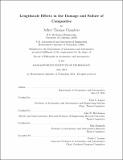Lengthscale effects in the damage and failure of composites
Author(s)
Chambers, Jeffrey Thomas
DownloadFull printable version (25.84Mb)
Other Contributors
Massachusetts Institute of Technology. Department of Aeronautics and Astronautics.
Advisor
Paul A. Lagacé.
Terms of use
Metadata
Show full item recordAbstract
The primary objective of this work is to investigate and identify lengthscale effects associated with damage in composite materials and their structures, and to determine how these lengthscales vary across levels of composites and can be used in assessing the overall response of composite structures. This is an advancement in a much larger pursuit towards developing a new methodology that utilizes composite failure and material data collected across all levels in order to predict the occurrence of damage and its effects at any operative level of composite structures. Documentation procedures are developed to capture qualitative and quantitative information on damage within experimental specimens, and computed microtomography provides additional information on the damage process. Specimens containing structural details are investigated postmortem to identify lengthscales associated with damage modes. Finite element models are developed in order to investigate the interaction of lengthscales associated with structural details with those associated with the basic damage modes. Based on these experimental and numerical results, lengthscales associated with five basic damage modes, as identified from previous studies, and the four structural details included in this investigation are identified and discussed, as are their interactions and importance. It is found that it is important to recognize two damage regimes, initiation and propagation, in characterizing lengthscales associated with damage modes. Identifying key lengthscales within each regime allows investigation of how the critical lengthscale(s) controlling the damage mode(s) change(s) across regimes. The concept of the "observable lengthscale" is identified as an important consideration when investigating lengthscales in experimental specimens and structures in that the observable lengthscale sets the ability to resolve damage and interactions of such. In a manner analogous to the "observable lengthscale," key lengthscales of basic damage modes and of structural details need to be used when choosing the scale of finite element models so that models have a resolution at least as fine as the key lengthscale of the mode under investigation. The results of the work show that the concept of lengthscales is a viable tool to characterize the overall response of composite structures, particularly involving damage initiation, damage propagation, and overall failure. The determination of how these lengthscales vary across levels in composites provides an important tool that can be used to assess this overall response of composite structures. Particular conclusions considering each damage mode are offered. In addition, a new damage type, called "transverse zigzag," is identified and studied, resulting in a finding that loads can "bypass" and "carry-through" regions of damage, depending on the geometry and laminate. Recommendations for further investigations are proposed based on the understanding of the role of lengthscales in the damage and failure of composites acquired from this work, and the needs identified to further this understanding.
Description
Thesis: Ph. D., Massachusetts Institute of Technology, Department of Aeronautics and Astronautics, 2014. This electronic version was submitted by the student author. The certified thesis is available in the Institute Archives and Special Collections. Cataloged from PDF version of thesis. Includes bibliographical references (pages 625-636).
Date issued
2014Department
Massachusetts Institute of Technology. Department of Aeronautics and AstronauticsPublisher
Massachusetts Institute of Technology
Keywords
Aeronautics and Astronautics.